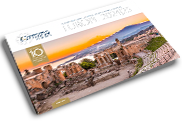8 Secrets of Pompeii and Herculaneum
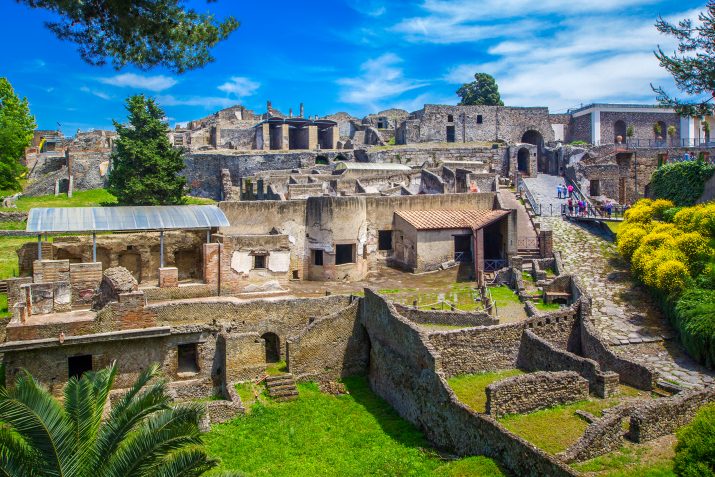
Pompeii and Herculaneum are ancient Roman cities located in the Campania region near Naples in southern Italy. They are famous for having been destroyed by the volcanic eruption of Mt. Vesuvius in AD 79. They were subsequently rediscovered in the late 1600s. Both cities provide a snapshot of everyday life in Roman towns – frozen in time by their burial. Their excavations in the mid 1800s marked the start of modern archaeology.
Why are Pompeii and Herculaneum so significant?
The commercial city of Pompeii is the larger and better known of the two sites. This city was home to 10,000-20,000 people (compared to 4,000-5,000 at the seaside resort of Herculaneum). Both provide invaluable information about life in a Roman city of the era. Including, how its residents lived and died, its politics, food, and daily activities. The excavations and ruins spurred an increased interest in the classical world. And the sites became popular stops on the European Grand Tour.
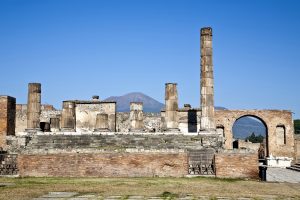
Ruins of Pompeii
How did it unfold?
Pompeii was the first to be destroyed in the volcanic eruption. This was because it was lying to the southeast of Vesuvius where the directive force of the winds blew. Herculaneum lay to the volcano’s west. It was hit by volcanic flows later. The destructive forces rained over the area for a total of three days.
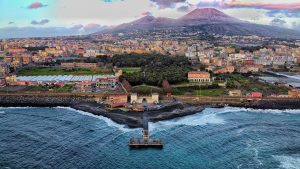
View of Mt Vesuvius over Naples
How did the eruption preserve these cities?
The nature of the volcanic forces varied between the two locations. Pompeii was slowly submerged under a blanket of ash and pumice. While Herculaneum was consumed by a fiery volcanic flow of molten rock. Upon cooling, the lava had buried the town 50-60 feet deep, making excavations much more difficult. However, this preserved its ruins much more than those of Pompeii.
The historical importance of these two locations was recognised when they were named as UNESCO World Heritage Sights in 1997. Here are some intriguing facts about Pompeii and Herculaneum!
Pompeii’s Secrets
- Lavish decorations: The archaeological research done at Pompeii has yielded a great deal of information about how its citizens lived. The mixture of affluent and ‘regular’ citizens, and their houses, offer fascinating insights into home life. The more affluent loved to adorn their homes with art. This included beautiful mosaics, frescoes and marble statuary in wall niches or indoor courtyard gardens.
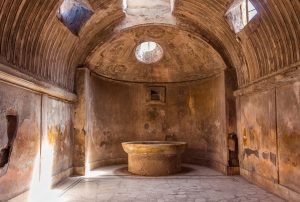
The interior of main public baths in ruins of Ancient Roman city Pompeii
- Robust diets: There were about 80 food shops, or thermopolium, discovered in the excavations at Pompeii. Traces of food and bones in the pots as well as waste remnants from the sewers shed light on the healthy diet of the locals. This consisted of a combination of fish, fruits, vegetables, nuts, and grains. Scans of skeletons found at the site indicated strong teeth, also indicating good nutrition.
- Politically inclined: Pompeiians were politically active, as evidenced by graffiti on its walls. There was an upcoming election when Mt. Vesuvius buried the city. Preserved political slogans and messages of support for candidates on its walls can still be seen today.
- Plaster casts: Scientific study has led to an understanding of how the unfortunate residents trapped by the explosion died. Skeletal scans indicated many perished from being simply crushed under collapsed buildings, or by head injuries from falling rocks. The falling volcanic ash hardened around the deceased. This ultimately left a ghostly outline behind after the body decomposed. Scientists poured plaster into these spaces, creating casts of the victims where they fell. You can view these casts that capture an image of the victims in their final moments.
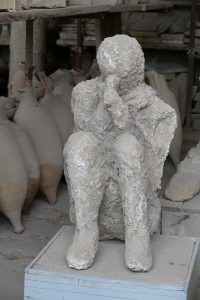
A plaster cast made from the Pompeii ruins
- When did the eruption actually occur? The date of the eruption was based on the first-hand observations and writings of Roman naturalist Pliny the Younger. Through this, it was long established that the date of Pompeii’s destruction was August 24, AD 79. But even this has been called into question due to the finding of a charcoal inscription on a house’s wall that carried the date of October 17th. Given that charcoal does not last long, some experts believe that the true date of the final destruction of the city occurred within a week after the inscription was made.
Herculaneum’s Surprises
- Unique preservation: The burial of Herculaneum under a deep layer of volcanic rock, combined with ground humidity created unique circumstances. This led to the higher state of preservation of these ruins, even more so than in Pompeii. Organic material such as wooden house frames and furniture have survived to this day. We can even find cloth and carbonised loaves of bread left in ovens! Also preserved was the colouration on certain works of art, including statues, which you are unlikely to find in many museum collections.
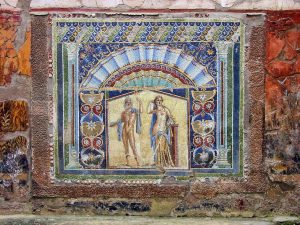
Beautiful colours of a mosaic found at Herculaneum
- Unfolding secrets: Some wealthy residents of Herculaneum built lavish mansions overlooking the sea. In the 1750s, one such villa was subsequently named the Villa of the Papyri. This was because over 1,000 papyrus scrolls that were found there. The Villa of the Papyri was used as the inspiration for the building of the original Getty Museum in California, USA. Although early excavators tossed aside the blackened charcoal lumps, these were later identified as scrolls from the villa’s library. Early restoration efforts were unsuccessful. Today, modern techniques are being developed to try to uncover the secrets of what writings the papyrus scrolls contain.
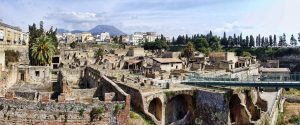
View over Herculaneum
- Trapped escapee’s: Due to Herculaneum’s location, its people had more time to escape. But there were victims here too! In 1980, around 300 human skeletons were discovered in arched vaults near what was then the coastline. While we can’t be sure, these people may have been waiting for boats to escape or simply taking shelter. These victims are a grim reminder of that day in AD 79 when the city was wiped out by the forces unleashed by Mt. Vesuvius.
Visiting these sites provides a rare glimpse into the past of ancient Rome. You can discover how the citizens of the two of its cities lived, worked, and ultimately met their fate. Join us in exploring the ruins of Pompeii as part of our 7-Day Highlights of Italy South Small Group Journey!
Tags: Naples, Pompeii, Herculaneum, Mt Vesuvius
